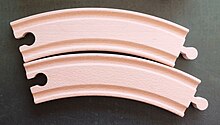Jastrow illusion
Appearance

The Jastrow illusion is an optical illusion described by the American psychologist Joseph Jastrow in 1892[1].
In the illustration below, the two figures are identical, although the lower one appears to be larger. The short edge of the upper figure is compared to the long side of the lower one.
This illusion is often included in magic kits and several versions are sold in magic shops. English magician Ian Adair invented the Butterfly Puzzle magic trick where the two shapes are caterpillars that turn into a butterfly.[citation needed]
-
With their left sides aligned, the lower figure appears larger
-
Shifting the upper figure to the right reveals their identical sizes
Wikimedia Commons has media related to Jastrow illusion.
References
- ^ Jastrow, J. (1892). Studies from the Laboratory of Experimental Psychology of the University of Wisconsin. II. The American Journal of Psychology, 4(3), 381. http://doi.org/10.2307/1411617
External links
- Reference to the illusion in World of Wonders; A Record of Things wonderful in Nature, Science and Art, Cassel, Petter & Galpin, London, 1873, p. 11.
- The train tracks optical illusion
- Prevos, Peter (2016). The Jastrow Illusion in Magic (List of marketed magic tricks and publications).


